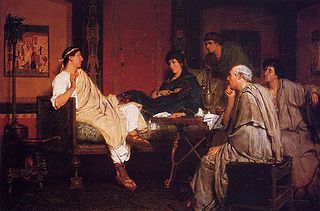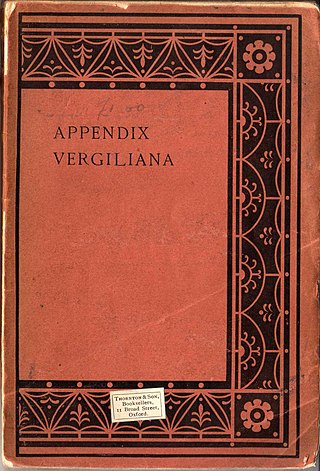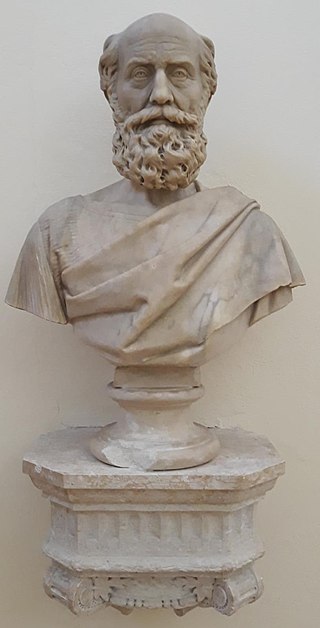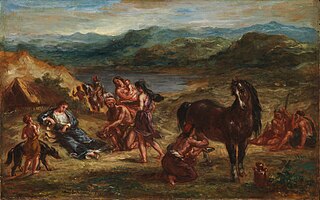Related Research Articles
The elegiac couplet is a poetic form used by Greek lyric poets for a variety of themes usually of smaller scale than the epic. Roman poets, particularly Catullus, Propertius, Tibullus, and Ovid, adopted the same form in Latin many years later. As with the English heroic couplet, each pair of lines usually makes sense on its own, while forming part of a larger work.

Publius Ovidius Naso, known in English as Ovid, was a Roman poet who lived during the reign of Augustus. He was a younger contemporary of Virgil and Horace, with whom he is often ranked as one of the three canonical poets of Latin literature. The Imperial scholar Quintilian considered him the last of the Latin love elegists. Although Ovid enjoyed enormous popularity during his lifetime, the emperor Augustus exiled him to Tomis, the capital of the newly-organised province of Moesia, on the Black Sea, where he remained for the last nine or ten years of his life. Ovid himself attributed his banishment to a "poem and a mistake", but his reluctance to disclose specifics has resulted in much speculation among scholars.

Albius Tibullus was a Latin poet and writer of elegies. His first and second books of poetry are extant; many other texts attributed to him are of questionable origins.
Marcus Valerius Messalla Corvinus was a Roman general, author, and patron of literature and art.
Sulpicia is believed to be the author, in the first century BCE, of six short poems written in Latin which were published as part of the corpus of Albius Tibullus's poetry. She is one of the few female poets of ancient Rome whose work survives.

Sextus Propertius was a Latin elegiac poet of the Augustan age. He was born around 50–45 BC in Assisium and died shortly after 15 BC.
Marcus Valerius Messalla Messallinus was a Roman senator who was elected consul for 3 BC.

The Tristia is a collection of letters written in elegiac couplets by the Augustan poet Ovid during his exile from Rome. Despite five books of his copious bewailing of his fate, the immediate cause of Augustus' banishment of the most acclaimed living Latin poet to Pontus in AD 8 remains a mystery. In addition to the Tristia, Ovid wrote another collection of elegiac epistles on his exile, the Epistulae ex Ponto. He spent several years in the outpost of Tomis and died without ever returning to Rome.

The Appendix Vergiliana is a collection of Latin poems traditionally ascribed as being the juvenilia of Virgil.

Gaius Cornelius Gallus was a Roman poet, orator, politician and military commander, at one time appointed by the Emperor Augustus as prefect of Egypt. Although only nine lines of his poetry are extant today, he was considered by Ovid as one of the major Latin poets of the 1st century BC.

Amores is Ovid's first completed book of poetry, written in elegiac couplets. It was first published in 16 BC in five books, but Ovid, by his own account, later edited it down into the three-book edition that survives today. The book follows the popular model of the erotic elegy, as made famous by figures such as Tibullus or Propertius, but is often subversive and humorous with these tropes, exaggerating common motifs and devices to the point of absurdity.

The Heroides, or Epistulae Heroidum, is a collection of fifteen epistolary poems composed by Ovid in Latin elegiac couplets and presented as though written by a selection of aggrieved heroines of Greek and Roman mythology in address to their heroic lovers who have in some way mistreated, neglected, or abandoned them. A further set of six poems, widely known as the Double Heroides and numbered 16 to 21 in modern scholarly editions, follows these individual letters and presents three separate exchanges of paired epistles: one each from a heroic lover to his absent beloved and from the heroine in return.

Aemilius Macer of Verona was a Roman didactic poet. He authored two poems, one on birds (Ornithogonia), a translation of a work by Boios, and the other on the antidotes against the poison of serpents (Theriaca), which he imitated from the Greek poet Nicander of Colophon. According to Jerome, he died in 16 BC. It is possible that he wrote also a botanical work. The extant hexameter poem known as Floridus or De viribus herbarum, traditionally ascribed to Macer, is actually a medieval production by Odo Magdunensis, a French physician.
Sabinus was a Latin poet and friend of Ovid. He is known only from two passages of Ovid's works.

The Double Heroides are a set of six epistolary poems allegedly composed by Ovid in Latin elegiac couplets, following the fifteen poems of his Heroides, and numbered 16 to 21 in modern scholarly editions. These six poems present three separate exchanges of paired epistles: one each from a heroic lover from Greek or Roman mythology to his absent beloved, and one from the heroine in return. Ovid's authorship is uncertain.

Ovid, the Latin poet of the Roman Empire, was banished in 8 AD from Rome to Tomis by decree of the emperor Augustus. The reasons for his banishment are uncertain. Ovid's exile is related by the poet himself, and also in brief references to the event by Pliny the Elder and Statius. At the time, Tomis was a remote town on the edge of the civilized world; it was loosely under the authority of the Kingdom of Thrace, and was superficially Hellenized. According to Ovid, none of its citizens spoke Latin, which as an educated Roman, he found trying. Ovid wrote that the cause of his exile was carmen et error, probably the Ars Amatoria and a personal indiscretion or mistake. The council of the city of Rome revoked his exile in December 2017, some 2000 years after his banishment.
The Garland of Sulpicia, also sometimes known as the Sulpicia cycle or the Sulpicia-Cerinthus cycle, is a group of five Latin love poems written in elegiac couplets and included in volume 3 of the collected works of Tibullus. The five poems concern a love affair between a girl Sulpicia and a young man Cerinthus. They are followed in the collection by a further group of six short elegies ostensibly written by Sulpicia herself describing the same affair.
The Panegyricus Messallae, also known as the Laudes Messallae, is a 212-line Latin poem in dactylic hexameters included in the 3rd book of the Roman poet Tibullus's collected works. It is a panegyric or praise-poem apparently written to celebrate the installation to the consulship of Tibullus's patron the Roman aristocrat Marcus Valerius Messalla Corvinus in 31 BC. The poem is numbered 3.7 in the Tibullus collection. It follows the six elegiac poems of "Lygdamus" and is followed by the five elegiac poems known as the Garland of Sulpicia.
Tibullus book 1 is the first of two books of poems by the Roman poet Tibullus. It contains ten poems written in Latin elegiac couplets, and is thought to have been published about 27 or 26 BC.
Tibullus book 2 is a collection of six Latin poems written in elegiac couplets by the poet Albius Tibullus. They are thought to have been written in the years shortly before Tibullus's death in c. 19 BC.
References
- ↑ "Both names are almost certainly pseudonyms." Navarro Antolín (1996), p. 21.
- ↑ The consuls were Pansa and Hirtius who died at the Battle of Mutina in northern Italy. The phrase might also refer to 69 AD or even 83 BC: Navarro Antolín (1996), pp. 4–5; 7; 17.
- ↑ Ovid, Tristia 4.10.6.
- ↑ Patricia Anne Watson, "Lygdamus", The Oxford Classical Dictionary, 4th ed. (Oxford University Press, 2012).
- ↑ This last group includes Lee (1958), Navarro Antolín (1996), and Maltby (2021).
- ↑ Navarro Antolín (1996), p. 6.
- ↑ cf. Propertius 3.6.2, 4.7.35.
- ↑ Navarro Antolín (1996), p. 21.
- ↑ The name "Neaera" first occurs in Homer's Odyssey 12.111, and it is also found in Virgil's Eclogue 3.1, Horace Epodes 15.11, Horace Odes 3.14.21, and Ovid's Amores 3.6.
- ↑ Though 45% is a high proportion, it is not as high as in Ovid's mature work, the Ars Amatoria, where it reaches 57%. See: Radford, R. S. (1920). "The Juvenile Works of Ovid and the Spondaic Period of His Metrical Art". Transactions and Proceedings of the American Philological Association, Vol. 51 (1920), pp. 146–171; page 151.
- ↑ Radford, Robert S. (1920). "The Juvenile Works of Ovid and the Spondaic Period of His Metrical Art". Transactions and Proceedings of the American Philological Association, Vol. 51, pp. 146–171; see p. 163.
- ↑ Cartault, A. (1911). Le distique élégiaque chez Tibulle, Sulpicia, Lygdamus. Journal des Savants, 9(2), 85–86; page 7.
- ↑ Radford, Robert S. (1920). "The Juvenile Works of Ovid and the Spondaic Period of His Metrical Art". Transactions and Proceedings of the American Philological Association, Vol. 51, pp. 146–171; see p. 165.
- ↑ Cartault, A. (1911). Le distique élégiaque chez Tibulle, Sulpicia, Lygdamus. Journal des Savants, 9(2), 85–86; pages 312–313.
- ↑ Navarro Antolín, p. 22.
- ↑ Navarro Antolín, pp. 22–24.
- ↑ Navarro Antolín (1996), pp. 93–96.
- ↑ Navarro Antolín (1996), pp. 147–8.
- ↑ Navarro Antolín (1996), pp. 193–4.
- ↑ Navarro Antolín (1996), pp. 258–260.
- ↑ There were several spas. The Aquae Caeretanae in Caere, on the coast near Rome, was a popular spa in the Augustan period: Navarro Antolín (1996), p. 413.
- ↑ Navarro Antolín (1996), pp. 459–464.
- ↑ Lygdamus 6.41.
- ↑ Navarro Antolín (1996), pp. 4–5.
- ↑ Navarro Antolín (1996), p. 6.
- ↑ Cartault, A. (1911). Le distique élégiaque chez Tibulle, Sulpicia, Lygdamus. Journal des Savants, 9(2), 85–86; pages 312–313.
- ↑ Radford, R. S. (1926). "The Ovidian Authorship of the Lygdamus Elegies". In Transactions and Proceedings of the American Philological Association (Vol. 57, pp. 149–180). (A shorter revised version is in: Radford, R. S. (1927). "The Ovidian Authorship of the Lygdamus Elegies". Classical Philology, 22(4), 356-371.)
- ↑ Baligan, G. & Paratore, E. (1950). "Ancora su Ligdamo". Aevum, 24 (Fasc. 3), 270–299; p. 282.
- ↑ Lyg. 1.16; cf. 3.16, 5.24.
- ↑ Tristia 4.10.21–2.
- ↑ Radford (1926), p. 155–6.
- ↑ Lee, A. G. (1958, January). "The Date of Lygdamus, and his Relationship to Ovid". In Proceedings of the Cambridge Philological Society (No. 5 (185), pp. 15–22).
- ↑ Somerville, T. (2020), "The Problem of Lygdamus and Ovid Reconsidered", Hermes 148(2): 173–197.
- ↑ Peter White in: Boyd, B. W. (Ed.). (2002). Brill's Companion to Ovid; page 7.